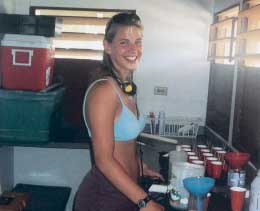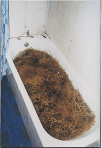|
|
 |
 |
 |
 |
|
ALUMNI PROFILEBrie Cokos ’01: Seaweed Farmer in Belize
Shunning the more traditional job tracks followed by most Ivy League graduates, Brie Cokos ’01 has taken up seaweed farming in Belize. It’s a good place for it: Not only does seaweed flourish in the Belizean waters, but the locals lust after seaweed cocktails, believed to have medicinal and aphrodisiac qualities. The stuff has export potential, too. Cokos first went to Belize for an internship for her biology major. She worked with the Wildlife Conservation Society and studied coral reef degradation from algae overgrowth. “I was left to fend for myself on a private island, Middle Caye, off the coast of Belize,” Cokos says. “It was really a culture shock, and initially I hated it, but after a while it grows on you — the Robinson Crusoe existence. Now, I can’t get enough of the sea and ecology of the islands.” After graduation, Cokos was hired by WCS and returned to Belize. While she was working to figure out why algae was overrunning the coral, she learned that a certain algae — the sea grass — is prized in the region and has usefulness beyond it. The seaweed grows like tumbleweed underwater, and is easily harvested by fishing it out. The locals have been doing just that for some time; gathering up the local supply, drying it out and feeding it into the blender as the key ingredient in their seaweed shakes.
Cokos gave it a try, hauling in some sea grass from around the island where she was working, soaking it in her tub overnight and stringing it around her balcony to dry. She then sold it to vendors, who pulverize it and mix it with condensed milk, cinnamon, nutmeg and other flavors. Rum raisin is a favorite of the locals, Cokos reports. Papaya is another. And peanut also is very popular. “Peanuts also are thought to be an aphrodisiac,” she says. “So peanuts and seaweed is a double whammy.” The problem is that because seaweed is so popular, it has been depleted in waters around the more accessible regions of Belize. There’s plenty of it further out in the water, for example on the island about 35 miles off the coast where Cokos was working, but the high cost of gasoline prevents most from making the boat trip out there. Enter: seaweed entrepreneurs. Because of her marine know-how, Cokos was introduced to two Belizean men who had founded a nonprofit organization, the Dangriga Development Initiative, which aims to develop alternative sources of income for local residents. Cokos joined them in a seaweed farming venture on the Belizean islands of Tobacco Caye Range on the Atlantic Barrier Reef. With her partners’ business sense and her algae know-how, along with some seed funding from a local U.N. organization, COMPACT, Cokos and her partners designed a way for local fishermen — and anyone else needing supplementary income — to cultivate and harvest the plant. “Even though the market is there and people love seaweed and sell it all over town, this had never been done,” says Cokos, who continues to consult with the WCS as well as do odd jobs to support herself while the seaweed project grows. Cokos set up an underwater test plot to figure out how best to grow the plant. Then, she and her partners pitched the process to potential local seaweed farmers. The work of raising seaweed is not complicated and is done in shallow, slow-moving waters right outside the farmers’ front doors, so nearly anyone can participate, Cokos says. She and her partners provide farmers with the basic seaweed farm setup and seedlings (taken from far off coast, not from the disappearing local supply); then, every two months, after the seaweed is harvested, they collect it and pay the farmers about $500, decent money for Belize.
The group’s goal is to set up 25 individual farms and to package and market the seaweed to larger companies in Belize and abroad that Cokos and her partners believe would be using more seaweed if they had a steady supply. American companies have already shown interest, and the price of exports to the U.S. is four times what the seaweed fetches in Belize. In addition to consumer uses, the carrageenan from seaweed can be used as a natural thickening agent for food and other products, such as paint and cosmetics, Cokos says. The Philippines already is cashing in on the plant, and a glance at some food labels will prove that many people have already had a dose. The team recently pitched the project for further funding to COMPACT, which promotes projects that support sustainability of the Atlantic Barrier Reef. Once the venture is fully up and running, Cokos would ideally like to spend part of the year in Belize and part back home in the States. In the meantime, being a seaweed farmer gives one a certain cachet in Belize. “When I tell people I’m involved with seaweed production,” Cokos says, “they have raised eyebrows and say, ‘Really?!’ ” For more about seaweed farming and life in Belize, please log onto www.belizeanjourneys.com and click on the article entitled, “Got Seaweed?” Cokos has several other articles on the site, as well. S.J.B.
|
|
||||||||||||||||||||||||||||||||||||||||||||||||||||||||||||||


